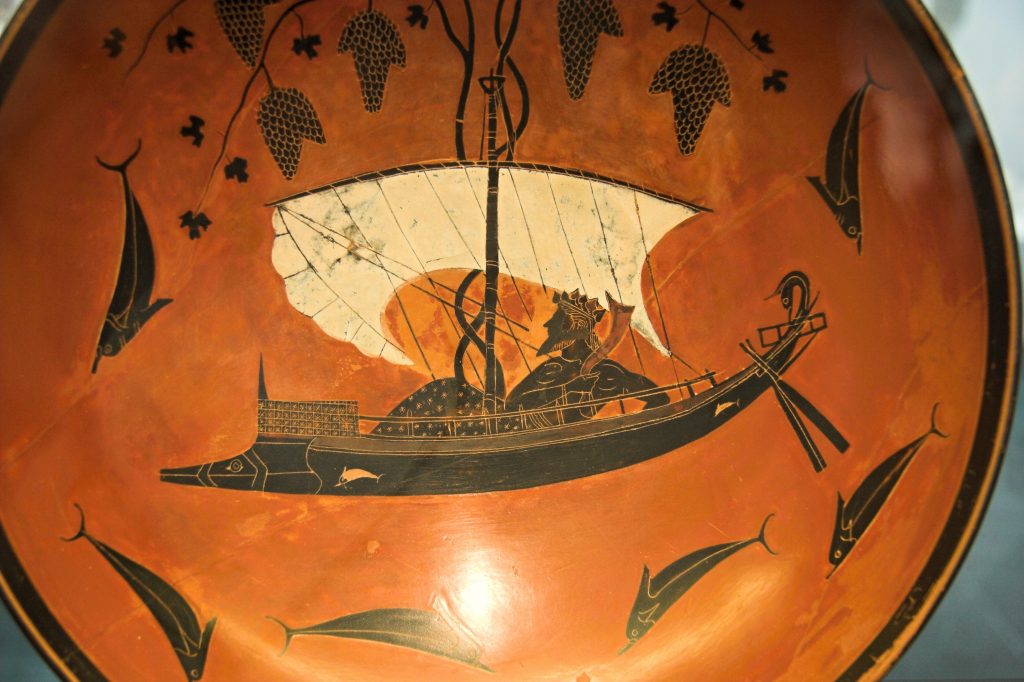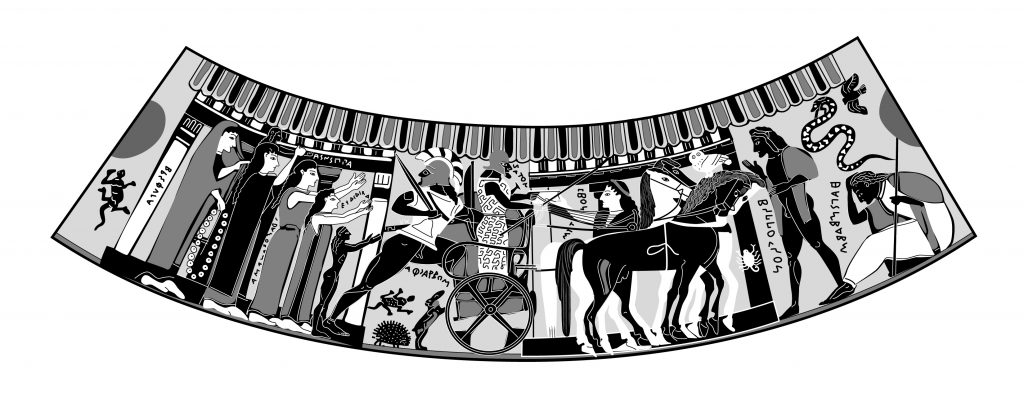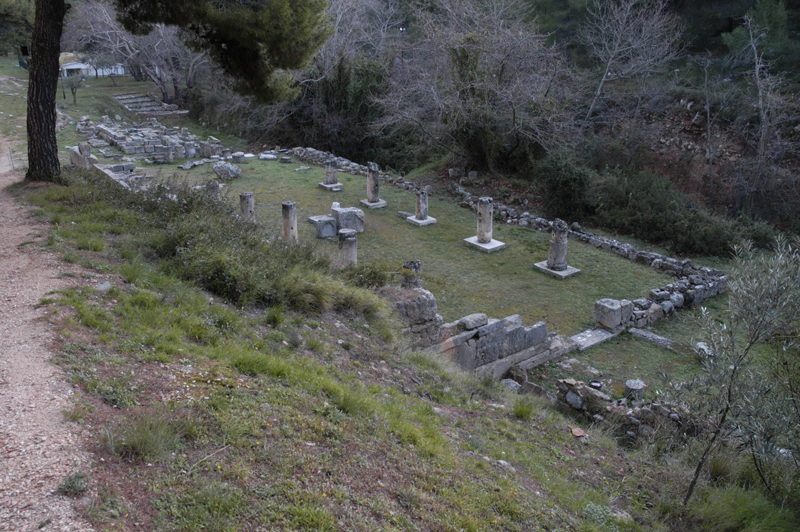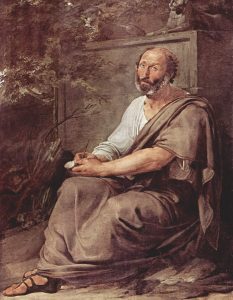This time the Core Vocab word—taken from terms in H24H[1] and the associated Sourcebook[2] —is sōphrōn [σώφρων] ‘moderate, balanced, with equilibrium’; sōphrosunē [σωφροσύνη] ‘being sōphrōn’.
In H24H, Gregory Nagy introduces the word as a metaphor describing the pilot of a ship in the Homeric Hymn (7) to Dionysus.
Literally, this word is a compound adjective consisting of the elements sō- and -phrōn, meaning ‘the one whose thinking [phrēn] is safe’, and the element sō- actually derives from the verb sōzein.
As we saw in Hour 21§33, this adjective sōphrōn in the sense of ‘moderate’ or ‘balanced’ applies to worshippers of the god Dionysus who find themselves in a mental state of equilibrium or balance when they participate in the rituals of Dionysus.
24§11. As we are about to see, the application of this adjective sōphrōn to the pilot in the Homeric Hymn to Dionysus is the signal of this man’s salvation, since he behaves in a morally moderate way—unlike the captain of the ship and the sailors commanded by the captain.
H24H 24§10
So with that in mind, here are a few more passages where the word appears.
In the Odyssey when Telemachus first arrives at Sparta Helen and Menelaos notice how like Odysseus Telemachus is. They do not ask him directly, though, so Peisistratos speaks first and makes the introductions:
Menelaos, son of Atreus, you are right in thinking that this young man is Telemachus, but he is very modest [sōphrōn], and is ashamed in his thūmos to come here and begin opening up discourse [160] with one whose conversation is so divinely interesting as your own.
Odyssey 4.156–160, adapted from Sourcebook
Peisistratos presents Telemachus as open to recognizing the almost divine status of Menelaos and Helen, just as the kubernētēs was open to recognizing Dionysus.
In Pindar, we hear about the family of Aiakos:
τοῦ μὲν ἀντίθεοι
25ἀρίστευον υἱέες υἱέων τ᾽ ἀρηΐφιλοι παῖδες ἀνορέᾳ χάλκεον στονόεντ᾽ ἀμφέπειν ὅμαδον: σώφρονές τ᾽ ἐγένοντο πινυτοί τε θυμόν.His god-like [25] sons and their sons, devoted to war, were the best [verb from aristos] in manliness, engaged in the brazen battle-throng that causes groans, and they were wise [sōphrōn] and prudent in spirit [thūmos].
Pindar Isthmian 8.24–26, adapted from translation by Diane Arnson Svarlien[3]
Even in the context of war it seems that keeping balanced is a worthy quality. Given the word’s connection with sōzein should this provide the warriors with the ability to save their comrades and themselves?
The seer Amphiaraos in the Seven Against Thebes of Aeschylus is presented in similar terms. The messenger describes him:
ἕκτον λέγοιμ᾽ ἂν ἄνδρα σωφρονέστατον,
ἀλκήν τ᾽ ἄριστον μάντιν, Ἀμφιάρεω βίαν:
570 Ὁμολωίσιν δὲ πρὸς πύλαις τεταγμένος
κακοῖσι βάζει πολλὰ Τυδέως βίαν:The sixth man I will name is of the highest moderation [superlative of sōphrōn] and a seer [mantis] best [aristos] in combat, mighty [biā] Amphiaraos. [570] Stationed at the Homoloid gate, he repeatedly rebukes mighty [biā] Tydeus with evils [kaka]
Aeschylus Seven Against Thebes 568–571, translated by Herbert Weir Smyth/Heroization Team[4]
He goes on to relate how Amphiaraos rebukes both Tydeus and Polyneikes for their part in the attack. Yet he he also has to attack…
..
… σῆμα δ᾽ οὐκ ἐπῆν κύκλῳ.
οὐ γὰρ δοκεῖν ἄριστος, ἀλλ᾽ εἶναι θέλει,
βαθεῖαν ἄλοκα διὰ φρενὸς καρπούμενος,
ἐξ ἧς τὰ κεδνὰ βλαστάνει βουλεύματα.No symbol [sēma] was fixed to his shield’s circle. For he does not wish to seem the best [aristos], but to be the best, as he harvests the fruit of his mind’s [phrēn] deep furrow, where his careful resolutions grow.
Aeschylus Seven Against Thebes 591–594
Although his story is not developed in the play, his role as a cult hero is mentioned several times in H24H based on various sources. And a cult hero is one whose mental abilities can save worshippers.
His death comes about when Zeus hurls a thunderbolt to open up the earth, and Amphiaraos, with his chariot, and horses, and charioteer, Baton) are engulfed after the battle. Gregory Nagy describes this type of event as “Scenario 4” in an outline of ways a hero can die and come back to life as a cult hero (H24H 18§43).
In analyzing the myths and rituals connected with the hero cult of Amphiaraos at Oropos in Boeotia, Pausanias (1.34.2) says that the worshippers of this cult hero at Oropos considered him to be a theos, ‘god’, and that all Hellenes eventually accepted such a status for this cult hero
H24H 15§33
Amphiaraos as described by Aeschylus manages to combine biā—another Core Vocab term, glossed by Gregory Nagy as ‘force, violence’— with being sōphrōn.
Perhaps Aristotle has a similar balance of qualities in mind when he compares the prime of life to youth and old age:
οἱ δ᾽ ἀκμάζοντες φανερὸν ὅτι μεταξὺ τούτων τὸ ἦθος ἔσονται ἑκατέρων, ἀφαιροῦντες τὴν ὑπερβολήν, καὶ οὔτε σφόδρα θαρροῦντες (θρασύτης γὰρ τὸ τοιοῦτον)οὔτε λίαν φοβούμενοι, καλῶς δὲ πρὸς ἄμφω ἔχοντες, [2.14.2] οὔτε πᾶσι πιστεύοντες οὔτε πᾶσιν ἀπιστοῦντες, ἀλλὰ κατὰ τὸ ἀληθὲς κρίνοντες μᾶλλον, καὶ οὔτε πρὸς τὸ καλὸν ζῶντες μόνον οὔτε πρὸς τὸ συμφέρον ἀλλὰ πρὸς ἄμφω, καὶ οὔτε πρὸς φειδὼ οὔτε πρὸς ἀσωτίαν ἀλλὰ πρὸς τὸ ἁρμόττον, [2.14.3] ὁμοίως δὲ καὶ πρὸς θυμὸν καὶ πρὸς ἐπιθυμίαν, καὶ σώφρονες μετ᾽ ἀνδρείας καὶ ἀνδρεῖοι μετὰ σωφροσύνης. ἐν γὰρ τοῖς νέοις καὶ τοῖς γέρουσι διῄρηται ταῦτα: εἰσὶν γὰρ οἱ μὲν νέοι ἀνδρεῖοι καὶ ἀκόλαστοι, οἱ δὲ πρεσβύτεροι σώφρονες καὶ δειλοί. ὡς δὲ καθόλου εἰπεῖν, ὅσα μὲν διῄρηνται ἡ νεότης καὶ τὸ γῆρας τῶν ὠφελίμων, ταῦτα ἄμφω ἔχουσιν, ὅσα δὲ ὑπερβάλλουσιν ἢ ἐλλείπουσιν, τούτων τὸ μέτριον καὶ τὸ ἁρμόττον.It is evident that the character of those in the prime of life will be the mean between that of the other two, if the excess in each case be removed. At this age, men are neither over-confident, which would show rashness, nor too fearful, but preserving a right attitude in regard to both, [2.14.2] neither trusting nor distrusting all, but judging [krinein] rather in accordance with actual [alēthēs] facts. Their rule of conduct is neither the noble nor the useful alone, but both at once. They are neither parsimonious nor prodigal, but preserve the due mean. [2.14.3] It is the same in regard to passion [thūmos] and desire. Their self-control [sōphrōn] is combined with courage and their courage with self-control [sōphrosunē], whereas in the young and old these qualities are found separately; for the young are courageous but without self-control, the old are self-controlled [sōphrōn] but cowardly. Speaking generally, all the advantages that youth and old age possess separately, those in the prime of life possess combined; and all cases of excess or defect in the other two are replaced by due moderation and fitness.
Aristotle Rhetoric 2.14, adapted from translation by J.H. Freese[5]
What other important concepts are related or contrasted with being sōphrōn? In what contexts is the word used, and what does it signal about a person who is described that way?
Notes
[1] H24H: Nagy, Gregory. 2013. The Ancient Greek Hero in 24 Hours. Harvard University Press, Cambridge, MA: 2013. Available online at CHS.
https://nrs.harvard.edu/urn-3:hul.ebook:CHS_NagyG.The_Ancient_Greek_Hero_in_24_Hours.2013
[2] Sourcebook: The Ancient Greek Hero in 24 Hours Sourcebook of Original Greek Texts Translated into English, Gregory Nagy, General Editor. 2018.08.06. Available online
[3] Pindar. Greek text: Sandys, John. 1937. The Odes of Pindar including the Principal Fragments. Harvard University Press, Cambridge, MA.; William Heinemann Ltd, London.
Available online at Perseus
Translation: Diane Arnson Svarlien. 1990. Odes. Pindar.
Available online at Perseus.
[4] Aeschylus. Greek text: Aeschylus, with an English translation by Herbert Weir Smyth, Ph. D. in two volumes. 1.Seven Against Thebes. Cambridge. Cambridge, Mass., Harvard University Press; London, William Heinemann, Ltd. 1926.
Available online at Perseus.
Translation: Herbert Weir Smyth. Revised by Heroization Team. Available online at the Kosmos Society Text Library.
[5] Aristotle: Greek text. Ars Rhetorica. Aristotle. W. D. Ross. 1959. Clarendon Press. Oxford.
Online at Perseus.
Translation: Aristotle. Aristotle in 23 Volumes, Vol. 22, translated by J. H. Freese. 1926. Harvard University Press, Cambridge MA; William Heinemann Ltd. London.
Online at Perseus.
Online texts accessed December 2018.
Image credits
Zde (photo) Dionysus on a ship sailing between dolphins. The mast is growing 7 grapes around the ship is 7 dolphins. Black-figure kylix from Vulci, Exekias Painter, circa 530 BCE. Staatliche Antikensammlungen München. Creative Commons CC SA 3.0, via Wikimedia Commons
Nefasdicere (photo). Amphiareion: Temple of Amphiaraos at Oropos. Creative Commons CC BY-SA 3, via Wikimedia Commons.
Scene from the “Amphiaraos Vase,” found at Cerveteri: once Berlin F 1655, now lost, from H24H Hour 7, Image O (7§83).
Francesco Hayez: Aristotle 1811. GNU Free Documentation License, via Wikimedia Commons
Note: Images have been selected from pictures that are freely available with open source or Creative Commons licenses or from photographs sent in by community members for the purpose. The images in this post are intended to suggest the subject, rather than illustrate exactly—as such, they may be from other periods, subjects, or cultures. Attributions are based where possible by those shown by museums, or on Wikimedia Commons, at the time of publication on this website.
Images accessed December 2018.
____
Sarah Scott has a degree in Language from the University of York where she specialized in philology, and has worked as an editor, technical author, and documentation manager. She is the Executive Producer for the HeroesX project, and one of the Executive Editors of the HeroesX Sourcebook. She is an active participant and member of the editorial team in Kosmos Society, with a particular interest in content development, document management, word studies, language learning, comparative linguistics, and digital humanities.



